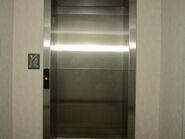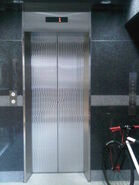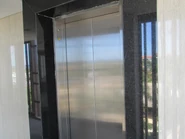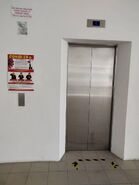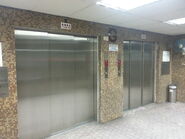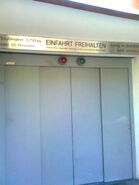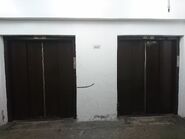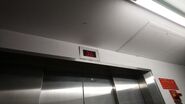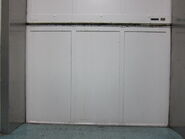Elevator doors have two major types, manual and automatic. Manual doors are normally opened and closed manually by hand, and automatic doors are the standard type of doors found in modern days elevators, usually powered by a door operator.
Non-automatic/manual doors
These doors are normally opened or closed manually using hands, although some of them close automatically. Most older and small European elevators from the 1950's to 1970's are using manual hinged door (similar to normal room doors), while the inside has a manual sliding scissor gate or often there is no door at all. For manual doors, sometimes the door can be spring loaded so the gate can't be left open, or the gate can automatically close when you press the button, and partly/completely close when the elevator gets to a floor. The inside door can also be a tubular gate, which is a gate that in many cases folds around the side of the cab when it is open (often called a barred gate by elevator enthusiasts, though this is likely not the actual term), and which can be automatic (which was firstly invented by Haughton, US Patent no.: 1707648[1]) or manual.
These type of door is still used today, normally for smaller wheelchair lifts or home elevators. Some older freight elevators may have a horizontal or vertical manual doors. In some Asian countries, one may find an old freight elevators with manual accordion or scissor gate. Some old elevators may have a semi-manual doors a configuration of manual door outside and an automatic door inside.
Automatic doors
Automatic doors are the standard type of doors found in modern days elevators which was introduced in 1887 (US Patent no. 371207[2]). Almost all the automatic doors are usually powered by a door operator installed on the elevator car[3]. Those except manual door with automatic door opening/closing device and all the incline elevators with every independent door operator belongs with every single shaft doors and car doors[4].
Single opening
A single opening door only has a single panel door spanning the doorway's width that opens to the left or right laterally. This is especially common in less expensive buildings and very common in older buildings in North America, Canada, and sometimes in European and Asian countries.
Center opening
Center opening doors are very common in elevators found in almost every building. This type of door consists of two panels that meet in the middle, and slide open laterally. One advantage of this type of door is high efficiency operation, but the disadvantage is the width of the door cannot be fully utilized.
Sliding telescopic doors
2 speed telescopic doors are common in bed, service and freight elevators, but are also common in passenger elevators, usually for those located in a small building or in an insufficient space where the doors cannot slide all the way through both side wall. In this type of door configuration (potentially allowing wider entryways within limited space), the doors run on independent tracks so that while open, they are tucked behind one another, and while closed, they form cascading layers on one side.
Other types of sliding telescopic doors:
- 3 speed sliding telescopic this configuration is normally found in older freight elevators and some passenger elevators, this type has three panels.
- 2 speed center opening telescopic commonly found in large passenger (such as those in airports), freight and very often bed elevators. This type has four door panels and open/close just the same as normal two center opening doors. Some older elevators may have outside center opening doors and four center opening telescopic doors.
- 3 speed center opening telescopic a very rare configuration that is commonly found in heavy-duty freight elevator and vehicle elevators. This is basically similar to the four center opening telescopic type but it has six panels of doors.
- Vertical bi-parting this type of door is usually seen on most freight elevators in the United States. The outer door is like a center opening door, but vertical. The inner door is usually a single door that goes up. Sometimes the inner door can be two speed. These doors can be automatic, or manual for older freight elevators.
- Vertical 2 speed telescopic this type of door is usually seen on most freight elevators and sometimes vehicle elevators in Asia. Both outer and inner doors are like horizontal two speed telescopic opening doors, but vertical.
- Vertical 3 speed telescopic just like horizontal three speed telescopic door but vertical. This type of door is very rarely used.
Folding inner doors
This type of door is seen on elevators with a swing hoistway door. This type of door has 2 sections, like a center open door, with 2 panels, that fold, causing the door to close. This type of door is usually seen on older elevators that formerly had no inner doors. This type of door is mostly seen in Europe, but can also be seen elsewhere, but not in the United States. There is also a type of folding inner doors with 1 section, and 4 panels, like a single slide door, but this type of folding inner door is very rare.
References
- ↑ US 1707648: Door-operating mechanism (Archived by Google Patent)
- ↑ US 371207: Elevator (Archived by Google Patent)
- ↑ hkelev - Door operator video clips & hkelev - Door operator video clips (2)
- ↑ Epic Climbing lift at IWM in Manchester
- ↑ Doordrive QKS9
- ↑ Wittur - AMD 2 car door operator
- ↑ Kone High-Performance Door Systems
- ↑ What is an elevator? (by Dover Corp.)

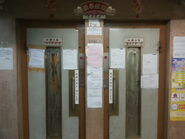
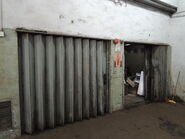






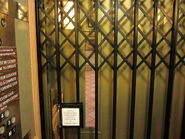


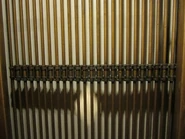


![Schindler mechanical door operator.jpg (1.28 MB) A Schindler QKS9 mechanical door operator[5] in Hong Kong. This door operator being lesser installations since mid-2000s, even the further variant QKS9-VF.](https://static.wikia.nocookie.net/elevation/images/c/c5/Schindler_mechanical_door_operator.jpg/revision/latest/scale-to-width-down/185?cb=20130304045304)
![Kone cable door operator.jpg (1.47 MB) A Kone AMD-1 linear door operator (supplied by Wittur Group AMD-2 door operator[6]) installed in the Kone MonoSpace elevator at Hong Kong MTR Causeway Bay Station (served between Ground Floor to East Concourse). This door operator is produced since 2000.[7]](https://static.wikia.nocookie.net/elevation/images/5/5d/Kone_cable_door_operator.jpg/revision/latest/scale-to-width-down/185?cb=20130316053234)


![Sematic door operator shaft.JPG (148 KB) Fermator shaft door component used on a Schindler 3300 AP elevator. The clutch in the next picture will touch the pick-up roller to unlock the shaft door interlock.[8]](https://static.wikia.nocookie.net/elevation/images/b/bf/Sematic_door_operator_shaft.JPG/revision/latest/scale-to-width-down/185?cb=20140719140041)







